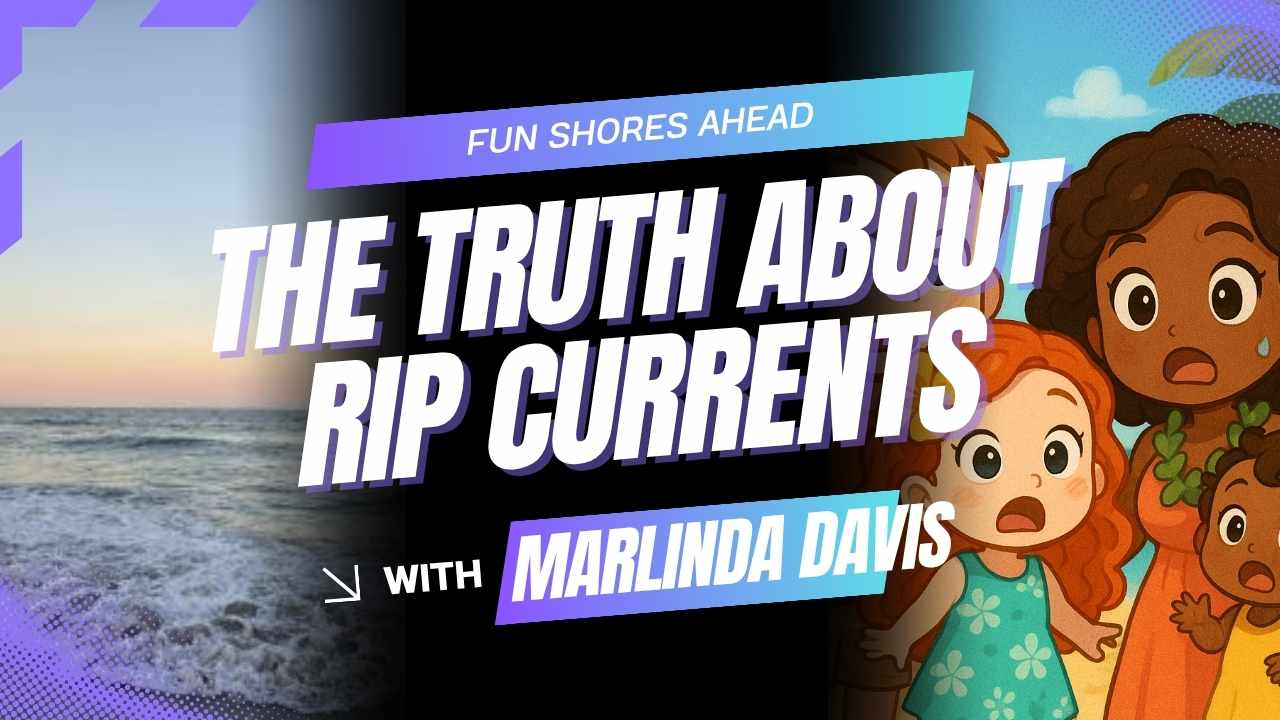We just got back from a beautiful day at Wrightsville Beach, and while the sun was shining and the views were picture-perfect, there was one thing we couldn’t ignore—the strength of the ocean. The waves were intense, the current was powerful, and even standing in knee-deep water felt like a mini workout (for real).
We weren’t alone in noticing it either. On the same day, according to FOX8 News, rescue crews at Wrightsville Beach responded to 10 rip current rescues. In one day. That hit us hard as a family who loves the water but wants to keep our kiddos safe while soaking in the sunshine.
So, let’s talk about:
- What Rip Currents Are
- How To Spot A Rip Current or Rip Tide
- What Families Need To Know Before Dipping A Toe In The Water
Because a beach day should be full of sandy snacks and happy splashes, not emergency rescues.
What Are Rip Currents (a.k.a. Rip Tides)?

Rip currents are fast-moving, narrow channels of water that flow from the shore back out to sea. They don’t pull you under like a whirlpool, but they can carry even strong swimmers far away from shore in just seconds.
These sneaky currents can pop up even on the most beautiful, sunny days. You might not see a big warning sign, but they’re out there—and they’re powerful.
What We Noticed at Wrightsville Beach, NC
The Wrightsville Beach, NC water looked inviting, but the undertow felt intense. Even our oldest, who’s usually confident in the waves, got a little nervous when her feet started slipping out from under her. And we stayed close—really close.
We also noticed flags and lifeguards out in full force. Lifeguards made at least 10 rip current rescues that day, and that doesn’t even count the countless families who played it safe and stayed out of the deeper water.
How to Spot a Rip Current
Rip currents can be hard to see, especially when you’re just trying to keep your toddler from eating a fistful of sand. But here are a few things to watch for:
- A break in the incoming wave pattern
- Choppy water that looks different from the rest
- Foam or seaweed moving away from shore
- Water that appears darker in a narrow path
If you’re unsure, always ask a lifeguard. They’re trained to identify and monitor rip currents and are there to help.
What to Teach the Kids (and Remind Yourself Too)

We sat down with our daughter after our beach day and talked about ocean safety. Here’s what we focused on—and what every family should review before beach time:
✅ Don’t panic if you get caught in a current
Trying to swim straight back to shore will exhaust you. Instead, swim parallel to the shore until you’re out of the current, then head in.
✅ Float, don’t fight
If you can’t break free, float calmly and signal for help by waving one arm. Teach your kids to do the same.
✅ Swim near lifeguards
Always. Even if you’re only planning to wade. Lifeguards saved multiple lives that day at Wrightsville Beach.
✅ Check beach warning flags and signs
We do this first thing when we arrive, and you should too. Red flags mean danger. Yellow means caution. Green means low hazard (but still be alert).
✅ Don’t turn your back on the water
Waves and currents can change in seconds. We take turns keeping watch while the kids play, even in shallow areas.
Final Thoughts
Wrightsville Beach was gorgeous and absolutely worth the trip, but our experience was a powerful reminder that nature deserves our respect. The ocean can be gentle and playful one moment and completely overpowering the next.
It only takes a few minutes of awareness to make sure your beach day is filled with safe, joyful memories. Talk to your kids, keep watch, and never underestimate the power of a current.
We’re all about fun shores ahead, but let’s make sure we’re smart about them too. 🌊💙
Have you ever experienced a strong current at the beach? Share your story—we’d love to hear how your family stays safe by the sea.
Comeback to @FunShoresAhead for beach safety tips, family-friendly coastal destinations, and everything you need to keep your seaside days sunny, sandy, and stress-free.

I live an hour from a beach down in south texas. However, I had never thought of researching waves and they work, Until now. I last went to the beach three weeks ago and I was surprised how deep I got in. I’m usually limited on how deep I go into the water but boy did I enjoy it. I did this thing where I let the wave drive me to shore, but swam at the same time as it pulled me. It was so much fun. I don’t ever remember having that much fin in waves. I can’t imagine how rips may seem. They may feel scary dangerous. I’ve gotta research if South Padre Island has rigs.
Hi Linda,
Thanks so much for sharing your beach experience! It sounds like you had an amazing time riding the waves—and I totally get the thrill of letting the water carry you toward shore. It can be so freeing and fun!
That said, I do want to gently share a little heads-up. What you described, where the wave pulls you out and you swim with it, is actually one way people sometimes get caught in a rip current without realizing it. I’m definitely not trying to be a Debby Downer, just looking out—because being informed helps you enjoy the beach with more confidence and safety.
South Padre Island does have areas where rip currents can form, especially near piers or jetties, or on days with stronger surf. It’s great that you’re planning to look into it! If you ever have questions or want tips on what to watch for, I’m always happy to help.
Stay safe and keep enjoying those waves—you’re clearly soaking up the best of what the beach has to offer! ????
Warmly,
Marlinda
Thank you for this and the helpful video you included on how to spot rips. Even though it is not that easy to see all the time, it was really helpful in getting me to understand how a rip tide works and why you get pulled out to sea so quickly.
I think all beach swimmers need an education like this before venturing into the water, as I have been caught in these a few times in my life and it is very scary. If I had known what to look for, it may not have happened. Also many drawings can be prevented with a little more education in this regard.
Thank you so much for sharing your experience and reflections—it really adds such meaningful depth to this conversation. I’m so glad the video helped clarify how rip currents work. You’re absolutely right that they are not always easy to spot, especially when you’re just excited to get into the water.
It’s powerful to hear that you’ve been caught in one before and can speak to how scary that moment can be. That firsthand perspective is exactly why education around rip currents is so important. A little knowledge really can make a life-saving difference, not just for ourselves but for the people around us too.
I completely agree—this kind of beach safety awareness should be more widely shared and taught, especially in family-friendly areas or tourist destinations.
Thank you again for your thoughtful comment and for helping to spread awareness. Wishing you safe and happy beach days ahead!0
Hi @FunShoresAhead,
This post is such an important reminder—especially for families who think of the beach as pure joy and relaxation. The visuals you painted of the waves’ strength at Wrightsville Beach brought it to life so vividly. Ten rescues in one day? That’s no small number, and it highlights just how deceptive sunny skies can be when rip currents are lurking below.
I really appreciate the way you explained rip current safety in a calm, practical tone. The “float, don’t fight” advice and tips on spotting those darker, narrow paths are incredibly useful. It’s amazing how even knee-deep water can pack a punch—and your experience makes ocean respect feel urgent, but not scary.
I’ll definitely be sharing this with friends and family before our next seaside outing. Thank you for turning your real-life moment into such a powerful teaching tool. Wishing your crew lots more sandy snacks and safe splashes ahead!
Warmly,
Oren
Health & Wellness Voyage
Hi Oren,
Thank you so much for this heartfelt and thoughtful message. It truly means a lot. You captured the spirit of the post so beautifully and, yes, the beach is absolutely a place of joy, but it also deserves our respect and attention, especially when it comes to rip currents and changing ocean conditions.
That day at Wrightsville Beach really stuck with me. Ten rescues in one afternoon was eye-opening, and I knew I had to share not to alarm people, but to help more families feel prepared. I’m so glad the “float, don’t fight” tip stood out. It’s such a simple phrase, but it can be life-saving when remembered in the moment.
Thank you for helping to spread this information. The more we talk about water safety in a calm, clear way, the more confident and safe families can feel during their beach adventures.
Wishing you and your crew many joyful, sun-soaked, and safe days by the shore too! Please feel free to tag me when you head out—I’d love to see where your voyage takes you.
Warmly,
Marlinda
@FunShoresAhead